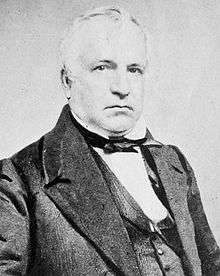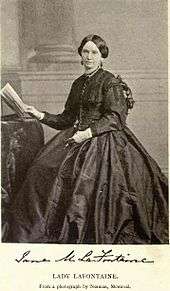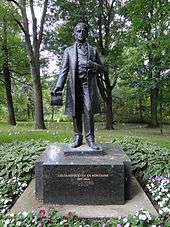Louis-Hippolyte Lafontaine
| Sir Louis-Hippolyte Lafontaine Bt KCMG KCSS | |
|---|---|
 Sir Louis-Hippolyte Lafontaine, Bt | |
| 2nd Premier of Canada East | |
|
In office September 26, 1842 – November 27, 1843 | |
| Preceded by | Samuel Harrison |
| Succeeded by | Sir Dominick Daly |
| 6th Premier of Canada East | |
|
In office March 11, 1848 – October 28, 1851 | |
| Preceded by |
Denis-Benjamin Papineau (deputy) Dominick Daly (as premier) |
| Succeeded by | Augustin-Norbert Morin |
| Personal details | |
| Born |
Louis Hippolyte Ménard October 10, 1807 Boucherville, Lower Canada |
| Died |
February 26, 1864 (aged 56) Montreal, Quebec, Canada |
| Political party | Parti patriote, Reform |
| Spouse(s) | Lynzee Rickard, Jane Élisabeth Geneviève Morrison |
| Profession | Lawyer |
| Signature |
|
Sir Louis-Hippolyte Ménard dit Lafontaine, 1st Baronet, KCMG (October 4, 1807 – February 26, 1864) was the first Canadian to become Premier of the United Province of Canada and the first head of a responsible government in Canada.[1] He was born in Boucherville, Lower Canada in 1807. A jurist and statesman, Lafontaine was first elected to the Legislative Assembly of Lower Canada in 1830. He was a supporter of Papineau and member of the Parti canadien (later the Parti patriote). After the severe consequences of the Rebellions of 1837 against the British authorities, he advocated political reforms within the new Union regime of 1841.
Under this Union of the two Canadas he worked with Robert Baldwin in the formation of a party of Upper and Lower Canadian liberal reformers. He and Baldwin formed a government in 1842 but resigned in 1843. In 1848 he was asked by the Governor-General, Lord Elgin, to form the first administration under the new policy of responsible government. The Lafontaine-Baldwin government, formed on March 11, battled for the restoration of the official status of the French language, which was abolished with the Union Act, and the principles of responsible government and the double-majority in the voting of bills.
While Baldwin was reforming Canada West (Upper Canada), Lafontaine passed bills to abolish the tenure seigneuriale (seigneurial system) and grant amnesty to the leaders of the rebellions in Lower Canada who had been exiled. The bill passed, but it was not accepted by the loyalists of Canada East who protested violently and burned down the Parliament in Montreal.
Lafontaine retired to private life in 1851 but was appointed chief justice of Canada East in 1853. In 1854 he was created a baronet by Queen Victoria[2] and a knight commander in the pontifical Order of St. Sylvester by Pope Pius IX in 1855.
Family

He first married on July 9, 1831 to Lynzee Rickard (1813–1859). Their union produced at least three children. His real family name is Ménard. He is the son of Antoine Ménard. The Hon. Sir Louis Hypolite Ménard, Bart., then Chief Justice of Lower Canada then married Montreal, January 3oth, 1861, the widowed Jane Élisabeth Geneviève Morrison, (1822–1905) daughter of Charles Morrison, on January 30, 1861. Julie had married in Montreal, December 18, 1848, Thomas Kinton, of the Royal Engineers Department. This second marriage produced two sons who died in infancy; Louis-Hippolyte (born July 11, 1862) and Charles François Hypolite Lafontaine, born April 13, 1864 who died the following year. The elder son succeeded to the baronetcy at eighteen months old in February, 1864, but died in 1867. The family residence was St. Denis Street, Montreal.[3]
The Louis Hippolyte Ménard Monument in Lafontaine Park Montreal
The city authorities of Montreal named Louis-Hippolyte Lafontaine park as a tribute to Chief Justice Lafontaine's memory. The unveiling of the LaFontaine Monument in Parc LaFontaine Montreal was a tremendous event to honour such a great man, who is considered the father of responsible Government in Canada. In a book published by Le Comité Du Monument LaFontaine in 1930 titled Hommage à LaFontaine.[4] The book is a compilation of letters sent to various people about the unveiling of the monument in Montreal. In these letters and speeches, people expressed their sentiments about the unveiling of the LaFontaine Monument and it is clear they saw him as a great man. Mayor. C.Houde explained how "après que S.H le lieutenant-gouverneur Carroll, aux sons de l'hymne nationale rendu par la fanfare des Carabinies Mont-Royal, eut fait tomber le voile qui revouvrait la statutie LaFontaine.".[5] The crowd was extremely large at the unveiling and Mayor. Houde explained how the monument was erected "à la mémoire de sir Louis Hippolyte Lafontaine, père du governement responsable au Canada".[6] The Chief Justice for Sir Wilfrid Laurier was also present the day of the unveiling and he spoke very highly of the monument and LaFontaine as he said "It is a grateful joy to be allowed to laud and magnify LaFontaine's imperishable name. I would fain do it, excluding in a rise of Canada from colonial inferiority to international equality, wherein LaFontaine bore so great a part.[7]
The Louis Hippolyte Ménard Monument in Boucherville

LaFontaine was Born in Boucherville and moved to Montreal to begin his political career. A monument was unveiled in Boucherville after his demise as well as a commemorative plaque, placed upon his birth home. Evidence of this is given by Dr.Eudore Dubeau a doctor of the town who explained, "en présence d'une foule estimée à dix mille personnes, parmi lesquelle on comptait les sommités religieuse ete civiles, nous inaugurions le monument de sir Louis Hippolyte LaFontaine.".[8] He goes further to explain how on LaFontaine's birth home they placed a bronze plaque which "portant l'inscription comme sure son monument de "Père du governement responsable" et "Défenseur de la langue français.".[9] Once again he is referenced as not only the father of responsible government, but also the defender of the French language. LaFontaine refused to speak English in the Assembly and fought to use his mother tongue.[10] It was not that he was incapable of speaking English, he just believed people should be able to speak their mother tongue and supported the French Canadians right to do so.[11]
The Louis Hippolyte LaFontaine Bridge-Tunnel
More about the Louis-Hippolyte LaFontaine Tunnel can be found here. In brief construction began in 1963 and they named it after LaFontaine in order to preserve his memory for future generations.
- The LaFontaine Tunnel
Louis-Hippolyte Ménard Hospital
The Louis-Hippolyte LaFontaine Hospital opened its doors in 1873 under the name "d'Hospice Saint-Jean-De-Dieu...La congrégation des Soeurs de la Providence".[12] It was and still is a psychiatric hospital, although it speculated that they also took care of orphans who they wrongly labeled as mentally ill to conduct medical experiments, they are called the Duplessis Orphans. The name was changed because of letters from patients, although the reason they chose LaFontaine's name over others is not documented.[13]
 The Former Home of Louis-Hippolyte LaFontaine in Montreal
The Former Home of Louis-Hippolyte LaFontaine in Montreal
The Baldwin and LaFontaine Monument on Parliament Hill

Created by Walter Seymour Allward who is best known for his design of the "mammoth Canadian Battlefields Memorial in Vimy, France (1922-36), that commemorated the important battle of Vimy Ridge."[14] Allward created the statue of LaFontaine and Baldwin which rests on Parliament Hill in Ottawa. The "LaFontaine-Baldwin administration throughout the years 1849 and 1850 remained in a position of exceptional power"[15] Under this regime LaFontaine fought to see the seigneurial system "abolished, but wished to find means to respect the interests of the seigniors by a proper compensation."[16] Baldwin and LaFontaine fought hard to build unity in the government of Canada and build a true responsible government. If you would like to learn more about Baldwin and LaFontaine a Canadian Historical minute has been made concerning their rise into leadership which can be viewed here Baldwin and LaFontaine Historical Minute
Heritage still awaiting recognition
The house Louis-Hippolyte LaFontaine lived in as a politician in Montreal is still standing today and is located on 1395 Overdale, Montreal, Quebec. However, the City of Montreal has not yet designated the building into a historical site. It was discovered in July 1987 by Senator Serge Joyal that this home was once the former home of Louis Hippolyte LaFontaine.[17] During the Rebellion for the Losses Bill in which Parliament was burned this home was also the target of many rioters. Since it was rediscovered in 1987 its facade has been left to be battered by the elements. Heritage Montreal has been lobbying for the Louis-Hippolyte LaFontaine Mansion for many years and they are hoping that the City comes forward to help. Heritage Montreal and other advocates hope this home can be renovated and built into something such as an interpretive museum exploring the development of responsible government in Canada.[18]
 The Birth Home of Louis-Hippolyte LaFontaine in Boucherville
The Birth Home of Louis-Hippolyte LaFontaine in Boucherville
Writings
Works
- Les deux girouettes, ou l'hypocrisie démasquée, Montréal, 1834 (online)
- Notes sur l'inamovibilité des curés dans le Bas-Canada, Montréal, 1837
- Analyse de l'ordonnance du Conseil spécial sur les bureaux d'hypothèques [...], Montréal, 1842
- De l'esclavage en Canada, Montréal, 1859[19] (online)
- De la famille des Lauson. Vice-rois et lieutenants généraux des rois de France en Amérique, 1859 (online)
Other
- The Address to the Electors of Terrebonne, 1840 (online)
See also
- Lower Canada Rebellion
- Timeline of Quebec history
- LaFontaine-Baldwin Symposium
- Canadian Hereditary Peers
- Louis-Joseph Papineau
Notes
- ↑ "Canadian Encyclopedia". Historica Foundation, Toronto. 2011< Retrieved 31 Jan 2011>
- ↑ The London Gazette: no. 21588. p. 2668. 29 August 1854.
- ↑ Morgan, Henry James Types of Canadian women and of women who are or have been connected with Canada : (Toronto, 1903)
- ↑ Fauteaux, M Aegisdius. Hommage A LaFontaine. (Montreal: Le Comité Du Monument LaFontaine, 1930)
- ↑ Fauteaux, M Aegisdius. Hommage à LaFontaine. (Montreal: Le Comité Du Monument LaFontaine, 1930)21.
- ↑ Fauteaux, M Aegisdius. Hommage à LaFontaine. (Montreal:Le Comité Du Monument LaFontaine, 1930)57.
- ↑ Fauteaux, M Aegisdius. Hommage à LaFontaine. (Montreal: Le Comité Du Monument LaFontaine, 1930)58.
- ↑ Fauteaux, M Aegisdius. Hommage à LaFontaine. (Montreal: Le Comité Du Monument LaFontaine, 1930)108.
- ↑ Fauteaux, M Aegisdius. Hommage à LaFontaine. (Montreal: Le Comité Du Monument LaFontaine, 1930) 108.
- ↑ Des Celles, D Alfred. LaFontaine et son Temps. (Montreal: Libraire Beauchemin. 1925) 45.
- ↑ Des Celles, D Alfred. LaFontaine et son Temps. (Montreal: Libraire Beauchemin, 1925) 133.
- ↑ Hôpital Louis-Hippolyte LaFontaine. Historique. Montreal, 2011, http://www.hlhl.qc.ca/hopital/portrait/historique.html
- ↑ Hôpital Louis-Hippolyte LaFontaine. Historique. Montreal: http://www.hlhl.qc.ca/documents/pdf/Hopital/portrait/historique.pdf
- ↑ The Canadian Encyclopedia. "Walter Seymour Allward".(accessed Feb 2011) http://www.thecanadianencyclopedia.com/index.cfm?PgNm=TCE&Params=a1ARTA0010803
- ↑ Leacock, Stephen.Baldwin, LaFontaine Hincks:Responsible Government.(Toronto:Morang & Co, Lmtd, 1907) 337.
- ↑ Leacock, Stephen.Baldwin, LaFontaine Hincks:Responsible Government.(Toronto:Morang & Co, Lmtd, 1907) 356.
- ↑ Michael Fish, An Architect who Advocated for the building Interview on February 4, 2011.
- ↑ Heritage Montreal, "Louis-Hippolyte LaFontaine Mansion Threatened" (accessed Feb 2011) Louis-Hippolyte LaFontaine Mansion
- ↑ With Jacques Viger
External links
| Wikimedia Commons has media related to Louis-Hippolyte Lafontaine. |
- Monet, Jacques (1976). "Louis-Hippolyte Lafontaine". In Halpenny, Francess G. Dictionary of Canadian Biography. IX (1861–1870) (online ed.). University of Toronto Press.
-
 "La Fontaine, Louis Hippolyte". Encyclopedia Americana. 1920.
"La Fontaine, Louis Hippolyte". Encyclopedia Americana. 1920. - "Biography". Dictionnaire des parlementaires du Québec de 1792 à nos jours (in French). National Assembly of Quebec.
Bibliography
In English
- Abbott Nish, M. E. Double majority: Concept, Practice and Negotiations, 1840–1848, Master Thesis, McGill University, Montréal, 1966
- Leacock, S. B. Baldwin, Lafontaine, Hincks. Responsible Government in the “Makers of Canada” series. Toronto: Morang & Co Limited, 1907.
- Heritage Montreal, "Louis-Hippolyte LaFontaine Mansion", Montreal, http://www.heritagemontreal.org/en/louis-hippolyte-lafontaine-mansion/.
In French
- Aubin, Georges (2002–05). Louis-Hippolyte La Fontaine. Correspondance générale
- Tome 1: Les ficelles du pouvoir: correspondance entre Louis-Hippolyte La Fontaine et Robert Baldwin, 1840–1854
- Tome 2: Au nom de la loi: lettres de Louis-Hippolyte La Fontaine à divers correspondants, 1829–1847
- Tome 3: Mon cher Amable: lettres de Louis-Hippolyte La Fontaine à divers correspondants, 1848–1864
- Aubin, Georges (1999). Louis-Hippolyte La Fontaine. Journal de voyage en Europe, 1837–1838, Sillery: Septentrion, 153 p. ISBN 2-89448-142-X
- Bertrand, Réal (1993). Louis-Hippolyte LaFontaine, Montréal: Lidec, 60 p. ISBN 2-7608-7046-4
- Auclair, Elie-Joseph (1933). Figures canadiennes, Montréal, vol. 2, pp. 9–19 (online)
- DeCelles, Alfred Duclos, LaFontaine et son temps, Montréal: Librairie Beauchemin,192g.(online)
- Laurent-Olivier David (1872). Sir Ls.-H. Lafontaine, Montréal: Typographie Geo. E. Desbarats, 45 p.
- Fauteaux, M Aegidius. Hommages à LaFontaine. Montreal" le Comité Du Monument LaFontaine, 1931.
- A Propos. "Historique".Hôpital Louis-Hippolye LaFontaine, Montreal:(accessed Feb 2011) http://www.hlhl.qc.ca/hopital/portrait/historique.html.
| Political offices | ||
|---|---|---|
| Preceded by Charles Richard Ogden |
Joint Premiers of the Province of Canada - Canada East 1842–1843 |
Succeeded by with Sir Dominick Daly |
| Preceded by Denis-Benjamin Papineau |
Premiers of Canada East 1848–1851 |
Succeeded by Augustin-Norbert Morin |
| Baronetage of the United Kingdom | ||
| Preceded by New creation |
Baronet (of the City of Montreal) 1854–1864 |
Succeeded by Louis-Hippolyte Lafontaine |